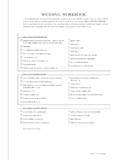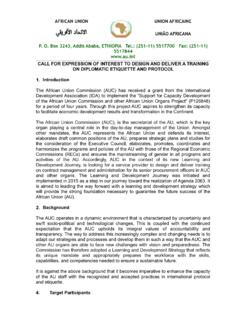Transcription of Dining-In and Dining-Out Handbook
1 UPDATE USAREC Pam 600-151 HeadquartersUnited States Army Recruiting CommandFort Knox, Kentucky 40121-27264 May 1994 USAREC Pamphlet 600-15 Personnel--GeneralDining-In and Dining-Out HandbookThis UPDATE printing publishes a new the Commander:STEWART K. MCGREGORC olonel, GSChief of StaffOfficial:ROGER H. BALABAND irector, Information pamphlet is a guide for con-ducting dining-ins or pamphlet is applicable to allelements of this on New Manning pam-phlet does not contain information that affects theNew Manning proponentagency of this pamphlet is the Office of theDirector of Training and Plans. Users are invitedto send comments and suggested improvementson DA Form 2028 (Recommended Changes toPublications and Blank Forms) directly to HQUSAREC (RCTNP), Fort Knox, KY of this pamphlet hasbeen made in accordance with USAREC Pam25-30, distribution B.
2 This pamphlet is publishedin the Recruiting Company Operations andAdministration (Listed by paragraph number)Purpose 1 Related publication 2 General 3 History 4 Planning and preparation 5 Duties 6 Guests 7 Invitations 8 Decorations 9 Sequence of events 10 Receiving line 11 Cocktail period 12 Seating arrangements 13 Table arrangements 14 Personnel support 15 Uniform 16 Color guard 17 Display of flags 18 Posting and retiring of colors 19 Welcoming remarks 20 Use of the gavel 21 Point of order 22 Menu 23 Limericks 24 Toasts 25 Gunners 26 The smoking lamp 27 Entertainment 28 Speeches 29 Music 30 Departing the mess 311. Purposea. The Dining-In is a traditional formal dinnerfor members of a military organization or unit. Itprovides an opportunity for members to meetsocially at a formal military function to recognizeindividual and/or unit achievements or anyevents which are effective in building and main-taining unit esprit de corps.
3 In addition to offeringgood food and beverages, it provides an atmos-phere in which unit tradition, history, and accom-plishments serve as a base for building andmaintaining professional camaraderie. A Dining-In may be held to honor one or more distin-guished visitors or to say farewell to departingmembers and welcome new ones. A dining-inshould be viewed as an opportunity to enjoy thecompanionship of one s fellow soldiers ratherthan as a mandatory Some dining-ins now are exercises in con-servatism, or how to have fun and not overin-dulge. Many still follow the old, lively pattern ofdining-ins held by units during World War usually include a period of fun and gamesafter the formal program of awards andspeeches. An addition to the tradition is thedining-out. This dinner may be held at a civilianrestaurant or in post facilities and is no differentin fun or frolic from a Dining-In , it usually includesspouses or guests, meaning a lighter menu,flowers on the table, and Related publicationFM 22-5 (Drill and Ceremonies).
4 3. Generala. Some units within the Army still conduct thetraditional Dining-In , but, like many social cus-toms and traditions, it has generally slipped intodisuse. Those units that do conduct the dining-infrequently follow their own procedures, sincethere is no single reference document in theArmy which deals with the subject This pamphlet is intended to act as a refer-ence and guide for an opportunity to add totradition and improve unit morale and esprit decorps through a formal Dining-In or pamphlet should assist you in conducting animpressive HistoryIt is believed that the practice of a Dining-In beganmany years ago in England. The origin wasprobably not a military function but instead acustom practiced in monasteries and early uni-versities. With the advent of the officers mess,the British military establishment adopted thecustom.
5 The close association and camarade-rie between British and American military forcesduring World Wars I and II led to the UnitedStates Army s adoption of the Dining-In as anintegral part of the regimental Planning and preparationa. Careful, detailed planning is required toensure that the occasion proceeds smoothly andis enjoyable. The details of the Dining-In or din-ing-out vary according to its purpose, but thosedetails must be thought through in advance. Thepurpose of a Dining-In or Dining-Out will determinehow it is conducted. The sequence of events fora Dining-In or Dining-Out held in honor of a foreigndignitary would be substantially different from thesequence planned for a Dining-In that involvesthe presentation of unit or individual Whatever the purpose, the presiding officerof the mess, usually the commander or his or herdeputy, has a great deal of latitude concerning2 UPDATE USAREC Pam 600-15conduct of the proceedings.
6 The key to success-ful execution of a Dining-In or Dining-Out is organi-zation. Experience indicates that a committeeshould be formed and tasked with organizing andexecuting the Dining-In . If duties permit, thecommittee chairman should be the presiding of-ficer or his or her deputy. The size of the com-mittee will vary depending on the purpose of theaffair, the extent of formality sought, and thenumber of individuals available to serve on Start early, 2 to 3 months before the timeset for the dinner. Preparation for the dining-inor Dining-Out should begin with selection of thedate, location, and tentative speaker well in ad-vance. The presiding officer must determineexactly when and where the Dining-In will takeplace. A specific date and place must be deter-mined before the committee can begin detailedplanning.
7 The best time to schedule the event isoften a Friday or Saturday night. The locationshould be easily accessible to most guests, andshould be held in a suitable place dictated bygood The committee will detail the various ar-rangements and should allocate individuals forspecific duties. An order of events or agendashould be prepared and published in a program should contain at a minimum, theagenda, menu, and biography of the guestspeaker; it may also include a listing of the toastsand their responses, award recipients, unit line-age, or other items of interest determined by thepresident of the mess. Formal invitations gener-ally are in order, extended far enough in advanceto elicit formal responses so that firm planningcan proceed. The dinner menu may consist offrom three to seven courses.
8 Toasts are consid-ered a mandatory part of the Dining-In . Activitiesgenerally are divided into a predinner social pe-riod with cocktails, the formal dinner, and aninformal period following the formal A planning checklist is provided at figure DutiesIt is essential that the key participants in theprogram ( , the color guard, chaplain, presid-ing officer, vice president (Mr. Vice), and guestspeaker) be knowledgeable of the role they willplay and are aware of the exact sequence President of the mess. The presiding offi-cial is usually designated the president of theopen mess and it is his or her responsibility tooversee the entire organization and operation ofthe Dining-In or Dining-Out . His or her operationaltechniques will follow those of any formal dinneraffair and will include appointment of a host andpersons or committees to take care of the ar-rangements, food, and protocol.
9 The presidentwill:(1) Set the date and place for the event.(2) Appoint committee chairpersons.(3) Appoint Mr. Vice, who should be junior inrank and selected for his or her wit and ability tospeak.(4) Arrange for a chaplain to give the invoca-tion.(5) Greet all guests before the dinner.(6) Open the mess with one rap of the gaveland close the mess with two raps.(7) Introduce the guest speaker and otherhonored guests.(8) Call upon Mr. Vice for the performance ofany duty deemed appropriate during the conductof the affair.(9) Secure an appropriate guest speaker,provide an outline of the event, and select somesuggested topic Mr. Vice. Mr. Vice should be seated at theopposite end of the banquet hall, at a separatetable, to permit the president of the mess to easilyface him or her during the dinner. Mr. Vice will:(1) Be the first to arrive at the mess.
10 (2) Open the lounge at the appointed time.(3) If dinner chimes are to be used, soundthem as appropriate.(4) Provide poems or witticisms in good tasterelating to particular personalities present.(5) Prepare appropriate toasts as directed bythe president.(6) Test the meat course prior to it beingserved and announce to the members of themess if it is fit for human consumption.(7) Be the last person to leave the mess.(8) Ensure that all colors and standards are ingood order before the event.(9) Monitor the smoking lamp.(10) Act as procedural intermediary for thepresident, his or her function is to add a lighttouch to the proceedings, prompting a comradelyexchange of banter and repartee.(11) Act as formal procedural control and rigidmaintenance of decorum, he or she may adjudge fines as appropriate to those members of themess who violate stated procedures.





